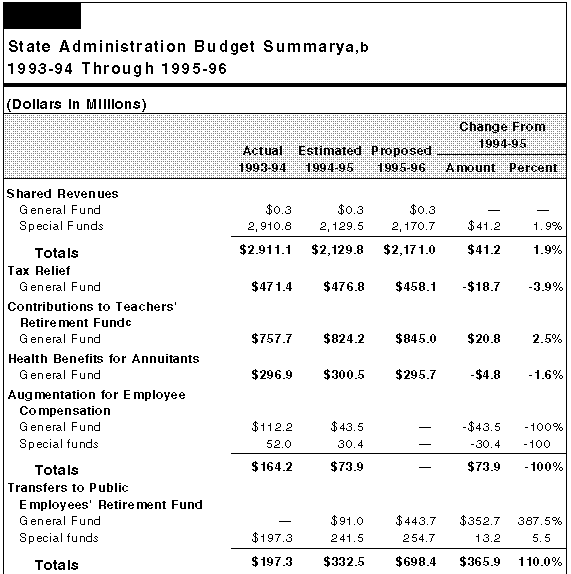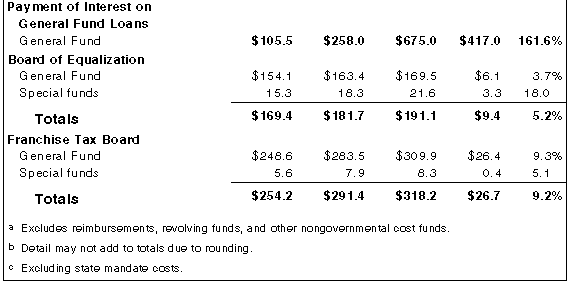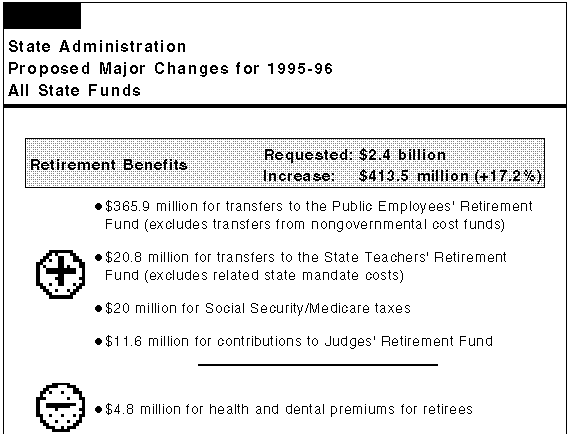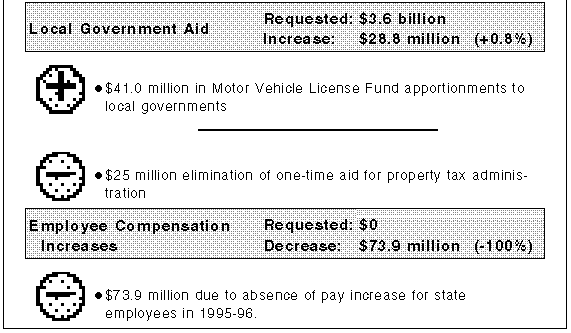Legislative Analyst's Office
February 22, 1995

The budget proposes total expenditures for state administration of $6.1 billion in 1995-96, an increase of 20 percent above estimated current-year expenditures. When adjusted for inflation, total expenditures for state administration have increased 20 percent since 1988-89. Proposed General Fund spending for state administration is $4.5 billion, or 11 percent of all General Fund expenditures proposed in the Governor's Budget for 1995-96.
Figure 1 (see next page) shows state expenditures for nine major administration programs in 1993-94 and 1994-95, and as proposed for 1995-96. The Department of General Services, while not included in this figure, is projected to spend $265 million on statewide support services, a decrease of $28 million, or 9.5 percent, less than current-year expenditures. The decrease is the result of the budget's proposal to transfer the functions and staff of the California State Police to the California Highway Patrol.


The largest program in state administration is the shared revenues program, which distributes state- collected revenue to local government agencies. The $41 million increase in spending reflects an increase in the Motor Vehicle License Fund (VLF) apportionments to local governments as a result of growth in the fee revenues collected.
The state provides property tax relief, both as subventions to local governments and as direct payments to eligible taxpayers, through seven tax relief programs. Historically, the two largest are the Homeowners' Property Tax Relief (Homeowners' Exemptions) and Renters' Tax Relief (Renters' Credit) programs. As part of the budget solutions over the last several years, however, the Renters' Credit program has been suspended from 1993 through 1995. The budget proposes a decrease of nearly $19 million for tax relief programs from $477 million in 1994-95 to $458 million in the budget year. This change primarily is due to the elimination of $25 million in one-time aid for property tax administration provided to counties in the current year, offset by mild growth in the number of taxpayers qualifying for the Homeowners' Exemption.
The Governor's Budget also proposes a state/county restructuring which would (1) shift approximately $1.9 billion in program costs from the state to the counties and (2) provide counties with $1.6 billion in state sales tax revenue and other resources. We discuss this proposal in detail in The 1995-96 Budget: Perspectives and Issues (see Part V).
PERS. The budget projects a $443.7 million General Fund transfer to the Public Employees' Retirement System (PERS) in 1995-96. The General Fund transfer in 1994-95 was only $91 million due to the one-time availability of offsetting credits. The 1995-96 General Fund contribution is based on the 1993-94 state employee payroll, pursuant to Ch 71/93 (SB 240, Committee on Budget and Fiscal Review). Under the provisions of that legislation, General Fund contributions to the PERS are made two fiscal years in arrears. As a result of a lawsuit filed by the PERS, the Superior Court in Sacramento County has ordered the state to immediately pay all deferred payments and to resume sending state funds to the PERS on a current, rather than deferred, basis. The state has appealed this decision and the budget assumes that the state will prevail on appeal. If the state loses the appeal, the General Fund impact could would be about $1 billion.
STRS. The State Teachers' Retirement System (STRS) receives contributions from teachers and their employers. These contributions, however, are insufficient to provide for the cost of teachers' basic retirement benefits and the protection of retirees' purchasing power. The shortfalls are covered by annual transfers from the General Fund. These transfers are expected to increase by $21 million, from $824 million in the current year to $845 million in the budget year. The increase is due to an expected increase in teacher payrolls, which is the key factor in the statutory funding formulas.
Health and Dental Premiums. The budget also includes $296 million from the General Fund to pay the state share of health and dental insurance premiums for retired state employees and their qualifying beneficiaries. This is $4.8 million less than estimated current-year expenditures. The reduction is the net result of significant decreases in the state contributions for health plan premiums (as calculated under the statutory formula), and an increase in the number of retirees.
Most state employees received a 3 percent pay increase on January 1, 1995. The budget does not compensate departments for the full-year (annualized) effect of that increase that will occur in 1995-96, with the exception of health, safety, and revenue-generating departments and those funded by special funds. The budget also does not propose funds for any new pay or benefit increases.
The collective bargaining memoranda-of-understanding (MOUs) that govern pay, benefits, and other working conditions for rank-and-file employees expire June 30, 1995. In his budget summary, the Governor expresses his expectation that management and labor can provide . . . a compensation program that is driven by performance and not by across-the-board compensation adjustments . . . , through new MOUs to be negotiated with labor's 21 bargaining units.
We discuss employee compensation issues in further detail in the Crosscutting Issues section of this chapter.
The Board of Equalization collects state and local sales and use taxes and various excise taxes and fees; oversees the administration of the property tax; assesses public utility property; and hears appeals of decisions by the Franchise Tax Board. The budget proposes expenditures of $191.1 million for the board in 1994-95 (exclusive of $91 million in reimbursements from local governments). This is an increase of $9.4 million (5.2 percent) over estimated current-year expenditures. About 25 percent of the proposed increase is attributable to the development and acquisition costs of an automated system to accelerate the collection of delinquent taxes. The Franchise Tax Board is responsible for administering California's Personal Income Tax, Bank and Corporation Tax, Homeowners' and Renters' Assistance programs, and the Political Reform Act audit program. Funding for the board is proposed to increase by $26.7 million, (9.2 percent) most of which is attributable to Bank and Corporation Tax computing system redesign expenditures.
Figure 2 (see page 10) portrays the changes in three major categories of expenditure (retirement benefits, local government aid, and employee compensation) which reflect some of the increase in state administration spending in 1995-96. Also shown are selected changes in each of the categories.


Retirement-related expenditures account for a significant part of state spending for the budget year. In 1995-96, state expenditures for various costs associated with public employee retirement (excluding University of California costs and nongovernmental cost funds) will total approximately $2.4 billion, including nearly $1.9 billion from the General Fund. As summarized in Figure 3, the General Fund provides for employer contributions and/or various other payments to four public employee retirement systems: the Public Employees' Retirement System (PERS), the State Teachers' Retirement System (STRS), the Judges' Retirement System, and the Legislators' Retirement System. In addition, the state (1) makes social security and Medicare contributions for most state employees and (2) contributes to the payment of premiums for health and dental benefit plans for retired state employees.
